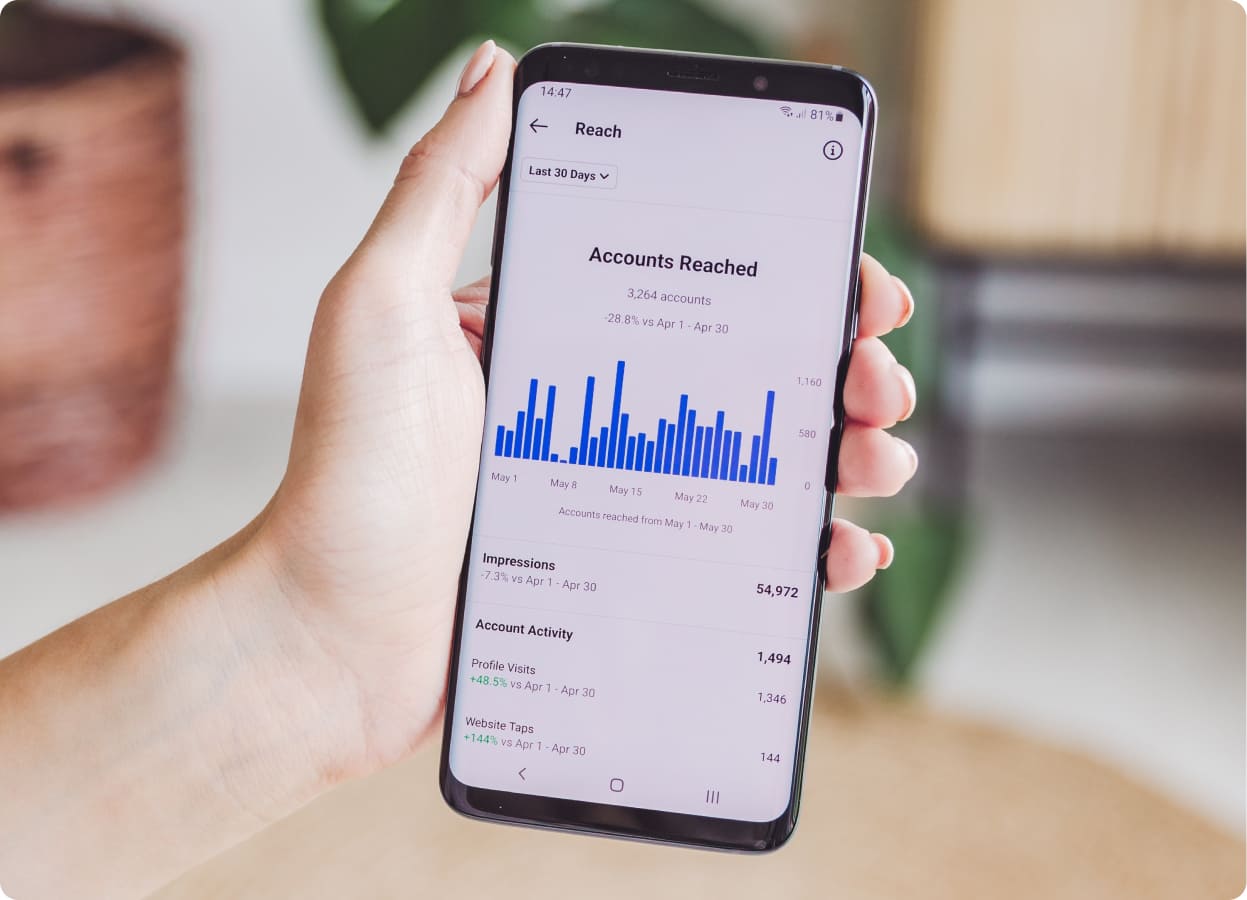What is content marketing and how can it help your business grow?
It's all about creating and sharing valuable, relevant, and engaging content to attract and retain a clearly defined audience.
 Source: Pexels
Source: Pexels
You know, when you're surfing the internet, you're not just mindlessly scrolling (or at least we hope you're not! 😝). You're on the hunt for something – whether it's the answer to a burning question, a how-to guide, or perhaps just a funny cat video to lighten your day.
Without even realising it, you're consuming content, loads of it. And more often than not, it's businesses that are serving up these tasty tidbits of information. But why do they do it? This is where content marketing comes into play.
Content marketing is the heart and soul of most digital marketing strategies these days. It's all about creating and sharing valuable, relevant, and engaging content to attract and retain a clearly defined audience – with the ultimate goal of driving profitable customer action.
It's not about blatantly promoting a brand but instead providing useful information to help customers make better decisions. And trust me, it's far from being a buzzword; it's a necessity in today's digital world.
In this article, we're going to do a deep dive into the world of content marketing. Not just what it is, but how it can seriously amp up your business growth. We'll explore how creating the right content can help you build brand awareness, generate quality leads, engage your customers, and position your business as a leading authority in your industry!

Source: burst.shopify
Understanding content marketing
Alright, let's get down to the nitty-gritty of content marketing. You know when you stumble upon a super helpful blog post that perfectly answers your question, or a funny yet informative video that not only makes your day but teaches you something new?
That's content marketing in action. It's about crafting valuable information into engaging content that not only grabs the attention of your audience but also keeps them coming back for more.
But content marketing isn't just about making your audience feel all warm and fuzzy inside; there's a method to the madness. The primary goal? It's not just about getting eyes on your brand, although that's a nice perk. It's about building trust and relationships with your audience.
When you provide them with content that solves their problems, answers their questions, or simply entertains them, you're building a connection. And guess what? People are more likely to do business with companies they trust and have a relationship with.
Now, the beauty of content marketing is in the mix. It's not just about writing killer blog posts or creating viral videos (though those can be part of it!). It's about using a variety of content types - from podcasts and webinars to infographics or even eBooks! - to engage your audience in different ways. And it's not just about creating the content; you also have to get it in front of the right eyes. That's where distribution channels like social media, email newsletters, and SEO come in.
And let's not forget about measurement. How will you know if your content marketing efforts are working? By tracking everything! You'll want to measure things like how many people are viewing your content, how long they're staying, whether they're sharing it with others, and more. These metrics will help you understand what's working, what's not, and where you can make improvements.
So, content marketing is like a jigsaw puzzle with various pieces - creating great content, distributing it effectively, and measuring the results. When these pieces come together, it's a beautiful picture of engaged customers and growing business. In the next sections, we'll delve into how this growth happens, and how you can make it happen for your business.
How content marketing drives business growth
So now that we've got a handle on what content marketing is, let's dive into the exciting stuff - how it can supercharge your business growth. Picture this: you've created an insightful blog post, shared it on your social channels, and boom! You're now on people's radar. You've kicked off a powerful cycle that'll drive your business growth. How, you ask? Let us tell you the secret.

Source: Pexels
1. Building brand awareness
Let's think about our daily lives for a second. How many times have you used Google to find a restaurant near you? Or maybe you've asked your friends on social media for book recommendations? The websites, blogs, or social media posts you end up clicking on and reading?
That's all part of a content marketing strategy working its magic. But it's not just magic. It's about building brand awareness.
You see, brand awareness is all about making sure people know your business exists. It's like throwing a party and ensuring that everyone you want to impress not only knows about it but is also excited to attend! But here's the thing – throwing a party is one thing; making sure it's the talk of the town is another. Content marketing is what helps you get there.
By consistently creating valuable, engaging content, you're not just telling your audience, "Hey, we're here!" You're saying, "Hey, we're here, and we've got something to say. Something that can make your life a little better or a bit more fun." It's about becoming a familiar face to your target audience – a source of information or entertainment they come to know, love, and trust.
And guess what? The types of content you can use to do this are virtually limitless. Let's take blogs, for instance. They're an excellent way to share your expertise, provide useful tips, or just share your company culture with the world.
Speaking of blogs, have you had a chance to check out our own? We're always sharing tips, insights, and stories designed to inspire and inform. Don't miss out – check out our blog section here! And guess what? You can also catch up on our latest posts on our app.
Then there are videos – tutorials, behind-the-scenes clips, interviews, the list goes on. And don't forget about infographics, webinars, podcasts – the list goes on and on! The trick is finding what kind of content resonates with your audience and delivering it on a consistent basis.
Take the example of Stakt, a yoga mat company that started sharing yoga workout videos and even free yoga classes-on-demand. Not only did it help them showcase their products, but it also gave their audience valuable content – a win-win situation! Or the tech start-up that began a blog to explain complex tech jargon in simple terms, building trust and recognition in the industry.
By creating and sharing content that's interesting and valuable to your audience, you're effectively putting your brand on the map. And the more familiar people become with your brand, the more likely they are to think of you when they need your product or service.
Read: How to maximise your fitness studio's online presence in 2023?

Source: burst.shopify
2. Generating targeted leads
You know how when you're fishing, you need the right bait to attract the fish you want? Well, think of content marketing as your bait, and your targeted leads as the fish. Just throwing a hook in the water won't do the trick – you need to provide something tempting that'll draw in those fish. In the world of business, it's all about attracting potential customers – we call them "leads."
Here's where content marketing gets really interesting. By creating content that your ideal customer finds valuable, you're essentially placing a tempting bait. When they take the bait, voila! You've got yourself a lead. But not just any lead – a targeted lead, someone genuinely interested in what you have to offer.
The content you create should be aimed at solving a problem or addressing a need that your target audience has. When you do that effectively, they'll naturally be drawn to you for more. They'll want to learn more, engage more, and even share your content with others. And that's how you generate leads.
But how do you convert these leads into customers? Here's where your content marketing strategy gets even more sophisticated. You can use techniques like gated content – that's content your audience can only access in exchange for their contact information.
For example, you could offer a free eBook, a webinar, or an exclusive video series, but to access it, your audience needs to give you their email address. That way, you're not only providing valuable content, but you're also building a database of potential customers.
Email marketing then plays a crucial role in nurturing these leads. With their permission (remember, no spamming!🙅), you can keep them updated with new content, offers, and more, all tailored to their interests. You're maintaining a relationship with them, so when they're ready to make a purchase, guess who they're likely to turn to? Yup, you've got it, it's you!
But remember, just like fishing, generating leads isn't just about throwing out bait and waiting. It's about knowing where to fish, what bait to use, and being patient. Sometimes, you might not catch anything, but other times, you might reel in a big one. So, keep at it! The more targeted your leads are, the more likely they are to convert to customers, helping your business grow. That's the power of content marketing!

Source: burst.shopify
3. Enhancing customer engagement
Have you ever been at a party where you hit it off with a complete stranger? You found common ground, shared a few laughs, and promised to keep in touch? That's a bit like customer engagement in the business world. It's about creating meaningful interactions between your brand and your audience, and content marketing is the perfect ice breaker at that party.
But you're not just throwing information at your audience and hoping something sticks. Instead, you're starting a dialogue, creating a two-way street of communication. You're sharing, they're responding, and you're responding back. It's like a friendly chat over coffee, except your coffee is your content, and your chat is the engagement you're driving.
Creating content that resonates with your audience is the first step. When they see a blog post or a video that sparks their interest, they're more likely to comment, share, like, or even reach out directly to you.
And guess what? Every like, comment, or share is an opportunity for you to engage. It's a chance to show your audience that there are real, caring humans behind your brand who are eager to connect and help.
The secret ingredient here is relevancy. You've got to know your audience well – their interests, their problems, their aspirations – and create content that aligns with these. The better you know your audience, the more effectively you can engage them. And the more engaged they are, the stronger their relationship with your brand becomes.
For example, a local yoga studio doesn't just post about their class schedules. They share wellness tips, yoga routines for different fitness goals, the benefits of different yoga styles, and even mindfulness exercises to help manage stress.
They ask their followers about their own wellness journeys, encouraging comments, shares, and personal stories. They create a community around their content, one that extends beyond the walls of their physical studio.
This isn't just about promoting their services; it's about providing value and engaging with their audience on a deeper level. It's about encouraging their followers to interact not just with the studio, but with each other, creating a vibrant, supportive community.
And every post, every comment, every share, is another opportunity for the studio to engage with its followers.
Engaged followers are more likely to become loyal members. They're more likely to share the studio's content, refer their friends, or leave positive reviews. They could even become ambassadors for the studio, advocating for the brand within their own circles.
So, while it may seem like the yoga studio is just sharing content and engaging in conversations, remember, every interaction matters.
Every engagement is a step towards building a stronger, more personal connection with their audience. And that can make a significant difference to their business growth. So, keep those interactions going, and watch your fitness business thrive!

Source: Unsplash
4. Establishing industry authority
Have you ever wondered why some brands seem to be the go-to experts in their field? Like that fitness guru everyone turns to for workout advice or that local bakery that's become the gold standard for fresh-baked sourdough.
It's not just about offering great products or services. It's about becoming an authority in your industry. And, you guessed it, content marketing is a powerful tool to help you achieve this status.
Think about it: when you're consistently delivering valuable, top-notch content that's relevant to your field, you're not just helping your audience. You're also showcasing your expertise and your understanding of the industry. You're saying, "Hey, we're not just another gym in the neighbourhood. We know our stuff, and we're here to guide you on your fitness journey."
But remember, becoming an authority doesn't happen overnight. It takes time, consistency, and yes, great content. It's about building trust and respect with your audience, one blog post, one video, one infographic at a time. It's about staying on top of industry trends, understanding your audience's evolving needs, and delivering content that meets these needs.
For instance, a yoga studio could not only share yoga routines but also explore the science behind yoga. They could talk about how different poses benefit the body, discuss the latest research in the field, or debunk common yoga myths. They could even collaborate with experts in related fields like nutrition or mental health to provide well-rounded content to their audience.
And the benefits of establishing your industry authority? They're worth the effort. When you're seen as an authority, people trust your brand more. They're more likely to choose you over your competitors. They're more likely to listen to your advice, try your products or services, and recommend you to others.
In essence, establishing industry authority is about becoming more than just a provider of goods or services. It's about becoming a trusted resource, a leader in your field. And with the help of content marketing, you can take your business from being another player in the game to being the MVP.
Read: What is unique selling points and what you need to know to create your own?
Implementing an effective content marketing strategy
Alright, we've talked about what content marketing is and how it can help your business grow. Now, let's get to the exciting part – how to create an effective content marketing strategy. It's like making a delicious cake; you need the right ingredients, in the right amounts, mixed in the right way. Sounds like a lot? Don't worry, we’ll make it simple for you as always!

Source: Unsplash
1. Identifying target audience
Imagine throwing a party where you only serve sushi, but then you find out half of your guests are either allergic to fish or don't eat it. Kind of a bummer, right?
Similarly, in the world of content marketing, you could create the most amazing content, but if it doesn't resonate with the people you're trying to reach, it's like that sushi party all over again. That's why identifying your target audience is the crucial first step in any content marketing strategy.
But hey, figuring out who your target audience is isn't a guessing game. It's not about assuming, it's about knowing. And how do you get to know them? Research, my friend, research.
You've got to dig in, learn about your audience's demographics, their interests, their challenges, and what they value. You need to know what makes them tick, what keeps them up at night, and what brings a smile to their face.
Think of a fitness studio, for instance. Is their target audience busy working professionals looking for quick, effective workouts? Or perhaps they cater to new moms trying to get back in shape while juggling the demands of motherhood? Or maybe they're targeting seniors seeking low-impact workouts to stay active and healthy. Each of these audiences has different needs, interests, and challenges, which means they would respond to different types of content.
Once you have a good grasp of who your target audience is, you can create a buyer persona, a sort of fictional character that represents your typical customer. This persona can guide your content creation, helping you tailor your content to the specific needs, interests, and concerns of your audience. It's like having a compass that points you in the right direction every time you create a new piece of content.
Identifying your target audience and understanding them well means you can create content that hits the mark every time. It's content that your audience finds useful, engaging, and valuable. And when your audience values your content, they'll value your brand. They'll come to you for advice, trust your expertise, and choose your services or products over others.
So, before you dive into creating content, take a moment to identify and understand your target audience. It's the difference between throwing a party that's a hit and one where half the food goes uneaten.

Source: Pexels
2. Developing a content plan
So, you've got a good handle on who your target audience is. You're all set to create content that they'll love, right? Hold on a second! Before you start churning out blog posts or videos, there's another vital step you need to take: developing a content plan.
Creating a content plan helps you organise your thoughts, your ideas, and your goals. It gives you a clear roadmap of what content you'll create, when you'll publish it, and how you'll promote it. It keeps you focused, on track, and saves you from the last-minute scramble of trying to figure out what content to post.
Let's say you run a yoga studio, and you've identified your target audience as working professionals looking for ways to incorporate mindfulness and exercise into their busy schedules.
With this audience in mind, you might decide to create a series of short instructional videos for quick morning routines, lunch break stretches, or wind-down exercises for the evening. You might supplement these with blog posts about the benefits of regular yoga practice, mindfulness tips for the workplace, or nutritious meal ideas for busy people.
Once you have your content ideas, map out a schedule. Maybe you decide to release a new video every Monday morning to kickstart the week, and a new blog post every Wednesday to keep the engagement going mid-week. Write it all down, along with where you'll publish each piece of content and how you'll promote it.
But a content plan isn't set in stone. It's a living document that changes and evolves with your business and your audience. Always keep an eye on how your content is performing. Are your instructional videos a hit? Are your blog posts driving engagement? Use analytics and feedback to refine your content plan, adjust your course if needed, and make sure you're always delivering valuable content to your audience.
Remember, your content plan is your roadmap to success in content marketing. It helps you stay focused, organised, and in tune with your audience's needs.

Source: Pexels
3. Creating compelling content
Alright, we've reached the exciting part! You know who your audience is, you've got your content plan in place, now it's time to roll up your sleeves and dive into the creative process.
Creating compelling content is all about offering value to your audience. It's about crafting content that informs, entertains, inspires, or solves a problem for your audience. It's about speaking to them in a way that resonates, that makes them feel seen and heard. It's about being authentic, being human, and connecting with your audience on a deeper level.
Let's take a bouldering studio for an example. If you're making a video about climbing techniques, don't just demonstrate the moves. Explain why each technique is useful, how it can improve a climber's experience. Throw in some real-life examples, maybe some bloopers or funny moments to make your audience laugh. Show the passion, the challenge, the fun of bouldering through your content.
The same goes for your written content. Don't just list facts about climbing safety. Share stories, anecdotes, tips and tricks. Make your content engaging and interactive. Maybe you could start a challenge, asking your followers to share their own safety tips or their funny climbing stories.
Remember, your content isn't just about promoting your business. It's about building a connection with your audience. It's about establishing your brand as a trusted, credible, and engaging source of information in your field. It's about giving your audience a reason to keep coming back for more.
One more thing, don't forget to add a dash of creativity. Use compelling visuals, catchy headlines, or interesting formats to make your content stand out. Experiment, iterate, and learn from your audience's feedback. What works for one brand might not work for another, and that's okay. Find your own style, your own voice.

Source: Pexels
4. Promoting and distributing content
So, you've identified your target audience, developed a killer content plan, and created some truly amazing content. Well done, you! But hold on, don't pop the champagne just yet.
There's one more step you need to take: promoting and distributing your content. Because let's face it, what good is the most delicious, beautifully decorated cake if it's left in a dark kitchen, unseen and uneaten?
You've got to get your content out there where your audience can find it, see it, and enjoy it. You need to promote and distribute your content in ways that make sense for your business and your audience.
Think of it like this: your content is a gift to your audience. But delivering the gift isn't as simple as dropping it off at their front door. You've got to find out where they hang out, what platforms they use, when they're most active, and deliver the gift there.
Let's get back to our yoga studio example. If you run a yoga studio and your target audience is busy professionals, where might they hang out online? Perhaps they're active on LinkedIn, where they keep up with industry news and network with colleagues.
They might also use Instagram for quick breaks during the day, scrolling through motivational quotes or short workout videos. They could even subscribe to health and wellness podcasts, listening to episodes during their commute or workout.
Once you've figured out where your audience is, plan how you'll distribute your content across these platforms. Perhaps you'll share your instructional videos on both LinkedIn and Instagram, post a link to your latest blog post on LinkedIn, and even turn some of your blog content into podcast episodes.
But remember, promoting your content isn't about spamming your audience. It's about adding value, being consistent, and staying authentic. Engage with your audience, respond to their comments, listen to their feedback. Make them feel seen and heard, and they'll keep coming back for more.

Source: Unsplash
Measuring and analysing content marketing success
You know what's just as important as creating top-notch content? Understanding how that content is performing.
Think about it. You've put in the work, you've shared your content with the world, but how do you know if it's working? Are people engaging with your posts? Are they sharing, commenting, clicking? Are your videos boosting sign-ups for your bouldering studio? These aren't just idle questions; they're crucial data points that can help you gauge your content's impact and influence.
That's where analytics come in. Today's digital platforms offer a wealth of metrics that can help you understand your content's performance or KPIs as the cool kids call them. These are the measurable values that show how effectively your company is achieving its key business objectives.
In content marketing, these could be things like website traffic, engagement rates (how many likes, shares, comments your content is getting), lead conversion (how many people downloaded your eBook or signed up for your newsletter), and even customer feedback (yes, the good old customer reviews!).
Remember, it's not just about producing content and throwing it into the abyss of the internet. It's about creating content that achieves a purpose - be it brand awareness, lead generation, customer conversion, or retention. So, make sure you're keeping a close eye on those KPIs!
Now let's get down to the nitty-gritty: tools. You know, those handy-dandy platforms that make our lives a bit easier. There's a boatload of them out there that can help you measure and analyse your content marketing efforts.
Google Analytics, for example, is a popular one that can give you a wealth of insights about your website traffic and user behaviour. Then there are tools like BuzzSumo for social media analytics or SEMRush for SEO and competitor analysis. Find the ones that work best for you and start digging into those numbers.
So, there you have it! Measuring and analysing might seem like a daunting task, but it's all part of the journey. It's the way you learn, improve, and continue to grow your business.
But remember in the end, measuring and analysing your content marketing success is not just about statistical numbers, it's about ensuring that your content is effective, that it's helping you reach your business goals. It's about continuous learning, adjusting, and improving.
Because in the world of content marketing, it's not just about putting content out there, it's about making sure that content helps your business grow.
Conclusion
We've been on quite a journey together, haven't we? From understanding what content marketing is, all the way to measuring its success, we've dived into the nitty-gritty of this powerful marketing strategy.
So, what's the big takeaway here? Content marketing is more than just a buzzword; it's a crucial tool that can help your business grow. It's about connecting with your audience, offering them value, building a relationship based on trust and respect. It's about creating content that resonates, that engages, that sets your brand apart.
But here's the most important part: it's not just about selling. It's about building a community. Offering value. Only by that, a business can become a trusted, respected, and engaging voice in the world of its niche. And that, my friends, is the true power of content marketing.
In conclusion, whether you're running a yoga studio, a boutique gym, or even a fitness startup, content marketing can be your secret weapon. It's a strategy that fosters connection, offers value, and builds trust. And in today's digital, connected world, those are the ingredients for business success. So go forth, create amazing content, connect with your audience, and watch your business grow!
Cheers,
Friska 🐨
Read next: 6 reasons why your fitness business needs a marketing strategy
Do you want to see more content like this? Follow us on Instagram and Facebook for more wellness advice, fitness trends, workout inspiration, and even best health and fitness deals exclusive to our followers. Don’t miss out!
.jpg)
